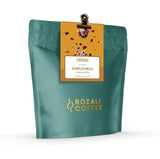





Delicate floral aroma with succulent citrus, creamy mixed berries and sweet toffee notes.
About
| Producer | |
|---|---|
| Region | |
| Altitude | |
| Variety | |
| Processing |
Processing
FARM STORY
Chelchele Washing Station
COFFEE VARIETY
Ethiopian heirloom
Opinie klientów o produkcie: Rozali Coffee - Ethiopia Chelchele Natural - espresso 1kg
Pozostałe oferty od
Rozali Coffee »
Rozali Coffee - Ethiopia Chelchele Natural - espresso 1kg
- 8%59,00 zł
54,00 zł
Najniższa cena produktu w ostatnich 30 dniach:
54,00 zł
 Darmowa dostawa od 0 zł
Darmowa dostawa od 0 zł
 Your title
Your title
OSTATNIO OGLĄDANE

Darmowa dostawa
do Paczkomatów
na terenie Polski

Godziny otwarcia
pn.-pt. 8:00 - 16:00

Zwroty zakupów
możesz zmienić zdanie
w ciągu 14 dni
bez podania przyczyny

Less waste
pakujemy w sposób
przyjazny dla środowiska
